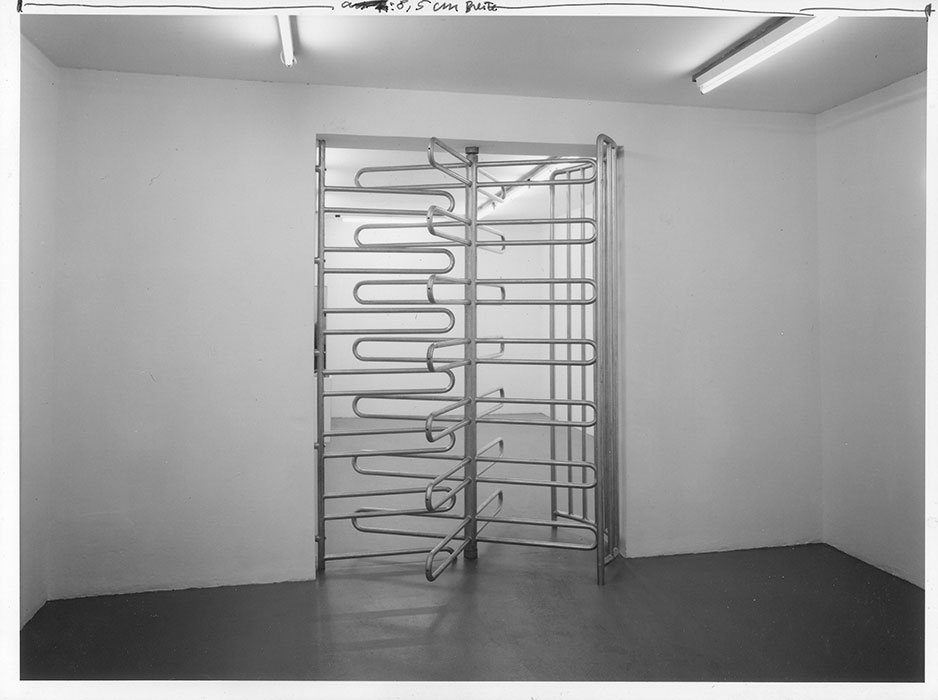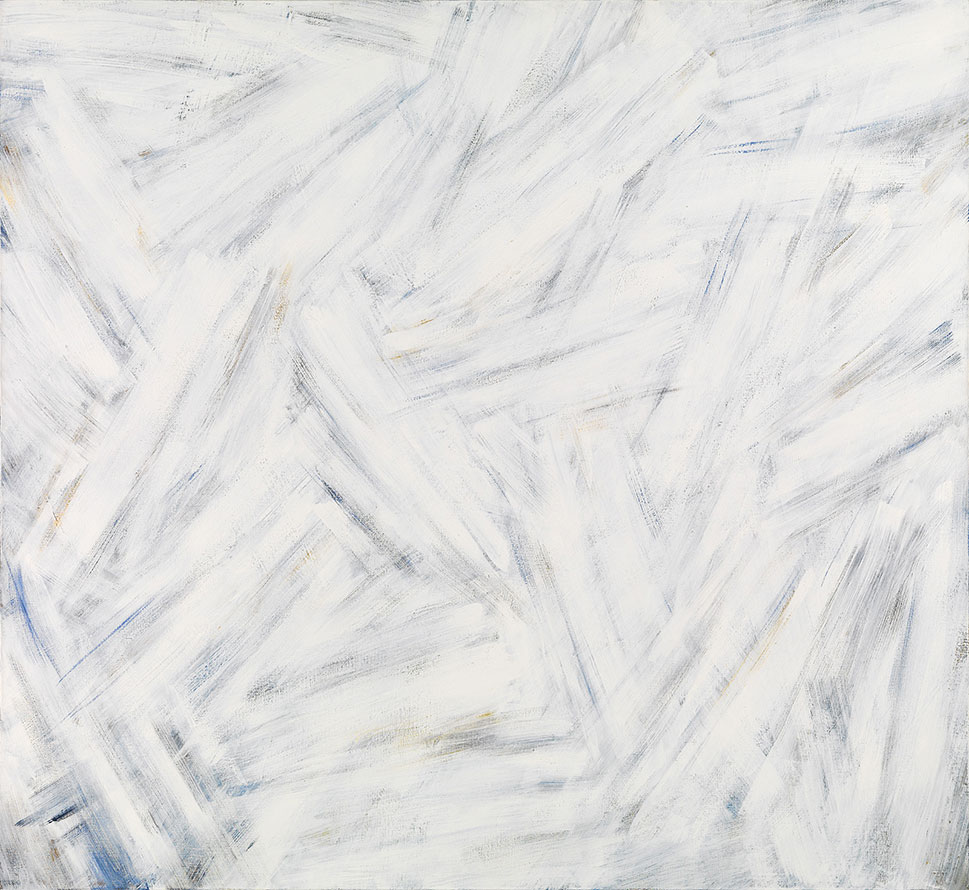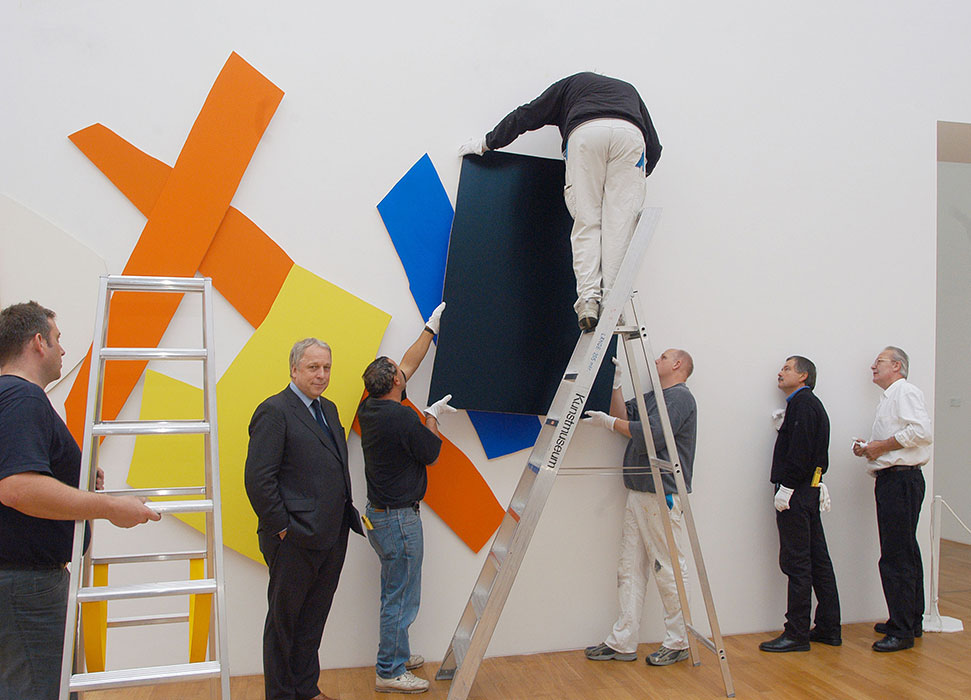“It is simply the most beautiful thing to meet with people who love art just as much as I do,” quotes “Weltkunst” the gallery owner Clemens Fahnemann. The Berliner with Westphalian roots (*1948 near Münster) approaches the subject of art with a tangible heart. In 2017, he looks back on 35 eventful and moving gallery years. DEEDS. spoke with him.
In 1980 the early thirties founded the gallery in West Berlin – initially as a publishing house. Clemens Fahnemann, who had studied visual communication in Stuttgart and Berlin and was a master student of Helmut Lortz, taught himself a specially developed artistic screen printing process at Künstlerhaus Bethanien. As a publisher, he was driven by the idea of animating artists to experiment with artistic screen printing. The artist’s profession would not have been an option for Fahnemann: “I’m so communicative and good with people. Lonely in a studio – that wouldn’t have been anything for me.
Abb. oben: Hanging of a work by Imi Knoebel in the Museum Bonn, Photo: Courtesy Galerie Fahnemann
At the end of 1982, the Fahnemann Gallery opened at Fasanenstraße 61, where it is still located today. “Cologne was then what Berlin is today. Everyone regretted that I was sitting in West Berlin and said: “Come to Cologne! But here in Berlin the artists were in their studios. And so I drew attention to art in West Berlin.” At that time completely unknown artists showed their first exhibition in the Galerie Fahnemann, among others Gerd Rohling, ter Hell, Rainer Mang and Reinhard Pods. Then Fahnemann concentrated on artists who set standards with their space-related works: Olaf Metzel, Hermann Pitz and Raimund Kummer. The effect: Metzel and Pitz were called to Documenta VIII (1987) and in the same year invited to Skulpturen-Projekte Münster, which has been held every ten years since 1977.

After the build-up work, solo exhibitions with Georg Baselitz, A.R. Penck, Frank Stella, Andy Warhol, Mutt Mallican, Allan Mc Collum, Bruce McLean, Bill Woodrow, Jessica Diamond, Donald Judd, Richard Tuttle, Yayoi Kusam, Imi Knoebel and Günther Förg followed.
The success continued. “Olaf Metzel and Frank Dornseif took part in the Skulpturenboulevard Berlin in 1987, which I co-founded with the Senator for Culture Dr. Hassemer. 1988 – Berlin was European Capital of Culture – there were two exhibitions of international standing outside the programme: Frances Picabia, first shown in Berlin, and Lucio Fontana. In 1988, parallel to major museum exhibitions in London and Stuttgart, I showed Frank Stella’s large-scale 14-part series “Had Gadya”. I was even able to acquire the series for the Kupferstichkabinett Berlin for DM 440,000 with funds from the Berlin Senator for Culture”.
Fahnemann also founded the “Graphische Gesellschaft zu Berlin – Vereinigung der Freunde des Kupferstichkabinetts e. V.” (Graphic Society of Berlin – Association of Friends of the Museum of Prints and Drawings). The extensive graphics collection of the married couple Hans and Uschi Welle, compiled with his advice, he passed on to the Kupferstichkabinett (DM 1.8 million). Many gifts from Fahnemann were added over the decades. This motivated many other collectors to donate to the Berlin Kupferstichkabinett.
And how it can happen, if you dedicate yourself to your work with skin and hair, your health didn’t take part any more in 1992. Clemens Fahnemann paused until 1999, when he reopened the gallery and worked his way up a second time. With exhibitions by Maurizio Nannucci, Astrid Klein, Per Kirkeby, Michael Wesely, Frances Scholz, Katharina Hinsberg and Pia Linz.

In retrospect, it is human moments that Fahnemann particularly appreciates. The first encounter with Imi Knoebel – one of his highlights. “I visited Imi in his studio. There was nothing of the arrogance of some artists. He spoke with me about his work in a friendly way. It was about art for both of us.” This gallery owner-artist relationship has lasted for 27 years until today.
Not only with Imi Knoebel, whom he had successfully mediated to the Neue Nationalgalerie and to Guggenheim/Deutsche Bank, and whose work “Revolver I”, shown by Fahnemann in 2003, recently achieved the highest price for a Knoebel work: 460,000 EUR. Fahnemann worked with Günther Förg for over 25 years until the artist’s death. He has been in charge of Raimund Girke’s work with the heiress and estate administrator Madeleine Girke for 15 years. He has represented Hans Hartung exclusively with the Fondation Hans Hartung, Antibes, for 19 years.

His recipe for success: an always precise gallery work, a consistent art historical classification and the understanding of artistic work from the ground up. And certainly above all the great heart of Clemens Fahnemann for art. “After all, art is what it is all about. Only that counts.
Galerie Fahnemann
Fasanenstraße 61 (1. OG)
10719 Berlin-Wilmersdorf
+49 30 8839897






